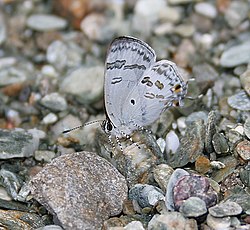| Chliaria kina | |
|---|---|
 | |
| At Samsing in Darjeeling district of West Bengal, India | |
| Scientific classification | |
| Kingdom: | Animalia |
| Phylum: | Arthropoda |
| Class: | Insecta |
| Order: | Lepidoptera |
| Family: | Lycaenidae |
| Genus: | Chliaria |
| Species: | C. kina |
| Binomial name | |
| Chliaria kina (Hewitson, 1869) | |
| Synonyms | |
| |
The blue tit is a species of lycaenid or blue butterfly found in parts of South Asia and Southeast Asia. It was traditionally called Chliaria kina [1] but the genus Chliaria is merged into Hypolycaena by many recent authors.
